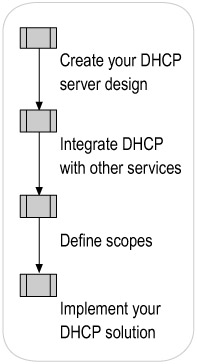Overview of DHCP Deployment
Valid IP addresses and other network options must be configured for all computers and other devices on the network, such as printers, in a corporate network. Manually configuring this information is a time-consuming process that adds significant costs to an organization and is susceptible to user error.
Windows Server 2003 Dynamic Host Configuration Protocol (DHCP) reduces the complexity and administrative overhead involved in managing network client IP addressing and configuration. DHCP allows you to assign IP addresses to network clients automatically and dynamically, as needed, and to automate, centralize, and simplify IP address and option configuration and distribution across your network. This protects against common configuration errors that occur when values are entered manually at each computer and helps to prevent address conflicts.
By using DHCP options, you can configure DHCP servers to supply a full range of configuration values when assigning a DHCP lease, allowing you to configure a large number of computers at one time, and to change configuration as necessary.
Different types of organizations can benefit from the automation and centralization that Windows Server 2003 DHCP provides, including:
-
Organizations in which administrators are responsible for configuring IP addresses and options for a large number of devices.
-
Organizations that include a large population of mobile users or network configurations that frequently change.
-
Organizations that already use versions of DHCP earlier than Microsoft Windows 2000, which can benefit from the added functionality of Windows Server 2003 DHCP by upgrading their DHCP deployment.
If you are deploying DHCP in a new Windows Server 2003 environment, begin your deployment process by creating a design for your DHCP servers. When you have completed all of the design steps for your DHCP infrastructure, you can implement your DHCP solution by configuring your DHCP servers. If you are upgrading your existing DHCP infrastructure to Windows Server 2003, begin by reviewing your current DHCP design and modifying it if required, and then migrate your existing DHCP databases.
DHCP Deployment Process
Deploying or upgrading DHCP in your organization involves several important planning, design, and implementation steps. Figure 2.1 shows the process for deploying DHCP.

Figure 2.1: Deploying DHCP
EAN: N/A
Pages: 146